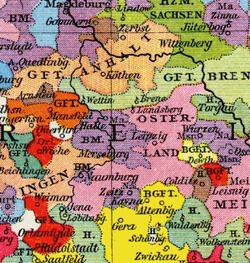
Back Bistum Naumburg-Zeitz German Episkopujo Naumburg-Zeitz Esperanto Principauté épiscopale de Naumbourg-Zeitz French Diocesi di Naumburg Italian Епископство Наумбург-Цайц Russian Biskopsdömet Naumburg-Zeitz Swedish
Prince-Bishopric of Naumburg-Zeitz Bistum Naumburg-Zeitz (German) | |||||||
|---|---|---|---|---|---|---|---|
| 968–1615 | |||||||
 The Prince-Bishopric of Naumburg around 1250 | |||||||
| Status | Prince-Bishopric of the Holy Roman Empire | ||||||
| Capital |
| ||||||
| Religion |
| ||||||
| Government | Prince Bishopric | ||||||
| Bishop of Naumburg | |||||||
| Historical era | Middle Ages, Early Modern Period | ||||||
• Established | January 2, 968 | ||||||
• Disestablished | 1615 | ||||||
| |||||||
| Today part of | Germany | ||||||
The Prince-Bishopric of Naumburg-Zeitz (German: Bistum Naumburg-Zeitz; Latin: Citizensis, then Naumburgensis[1] or Nuemburgensis)[2] was a medieval diocese in the central German area between Leipzig in the east and Erfurt in the west. The seat of the bishop was Zeitz Cathedral in Zeitz from 968 and 1029 and Naumburg Cathedral in Naumburg between 1029 and 1615. It was dissolved in the wake of the Reformation. The Bishopric of Zeitz-Naumburg encompassed the four archdeaconries of Naumburg, Zeitz, Altenburg and "trans Muldam" (comprising the sub-districts (Unterbezirke) of Lichtenstein, Glauchau, Hartenstein and Lößnitz).
- ^ Seeley (1854), App. II, p. 831.
- ^ Cheney (2015).
